#yqt
Text
STARVING WHITE WOMAN MILLIA RAGE
#AURUAWEURU)W#RUOQ#WTR(F#YQT)FY#ETE$WIPGHEW$GER#WE JSUT WATCHED THE FIRST EPISODES OF STAMPEDE TO SEE WHAT ITS LIKE AND IM OUAUG#txt#literally the most catered to my interest image in the world starving white woman has been my discord banner for ages now
7 notes
·
View notes
Video
youtube
The TERRIFYING Link Between Elon Musk And The Mark Of The Beast...!
0 notes
Text
‡ ‡c‡bu‡j gyblz‡ma tuy※tz‡r gz‡tuy※‡sgmr fksa, tsl ‡v‡ft'u m z‡mtv‡k jz‡c hy ※‡‡j zy‡tk‡d‡j yt ‡ft jv‡‡q v‡‡sw bv‡g t‡fu zy oa jvmylfumj gz‡‡l bbm zy‡tmvyjm vyh ‡ft ot‡b‡lmhh‡z‡ fumbu uk‡tmamvjyb‡a hy usyv‡jvsa gz‡avyhuzmvt v‡tsy / ‡z‡fkma ujyg ayvh u‡‡v‡u' j‡v‡a ※‡‡j z‡ ‡ft ‡t‡z‡hz‡ ‡vsb‡mh hy ‡vstbsk z‡ ‡uyft t‡bbmq / fktyvk gz‡cksu u‡z‡gz‡.
vyh v‡r‡tmfq ‡r‡tk‡※uv‡※ oa jv‡‡q v‡‡sw bv‡g t‡fu u※‡‡c, gz‡yg tsy z‡ m gz‡cksh umg cuma yt ‡rv‡u‡v※ gz‡ftozm bb‡tu gz‡bla‡u‡v ftbm‡f. gz‡v‡hhsu fgsyvft ob‡mj q‡z u‡fumv jzm utb‡q
ayvh u‡‡gv‡bbm yt uzy‡tmtu‡hz‡ hy tusj-uv‡tm‡ ‡blmtkmvtz‡ yt m ‡zy-zyuv‡※ tz‡atvm※m gz‡jbyf yqt ‡b※y‡※ jzm ‡‡vft u‡a‡t‡h‡b hy uzy‡uu‡uuy※. gz‡cvyq omqm zy tkmvtulm bmuuolm ‡kzmz‡asb tmft uckmb vyh u‡‡vvsh vy u‡zyl vy utylyv, gz‡ojstu jzm gz‡ksjyv※ ‡ft fksa ‡vya bmvya ‡a‡t-uasskkmr hy ‡vz‡g.
‡ayu vm‡o ‡'bb obbmstkm ‡rmf m ‡blmomb※ ‡amg ft‡q bmtz‡j‡kz‡ tyf z‡ayq z‡ t‡ jzm u‡ft'bb bbm ‡l tusd jml u‡‡vya‡a, ‡ omu ‡‡vft jzm m hbmf uvm‡o z‡. fg‡u. t'zjbsyfu uum※ tz‡agjsd zy tmfq ‡b※y‡※ uu‡kyv※ gz‡※umbbyk masmvtjbvyq ft‡q vy bb‡c ‡a‡t ft‡q, tsl z‡fq gz‡ovt yt ‡cma u‡ft hhstu vyh tmft gzyb t‡ ugz‡tu tuyabm um fksa um ‡u‡ft u‡fumv yj.
3 notes
·
View notes
Text
وظائف شاغرة (Global Projects Services) للجنسين براتب 11500 ريال
وظائف شاغرة (Global Projects Services) للجنسين براتب 11500 ريال
رابط المقال:
https://wp.me/p9udBr-yqT
#فرص عمل#وظائف خالية#وظائف للرجال والنساء#وظائف شاغرة#وظيفة#شغل#وظائف حكومية#وظائف قطر اليوم#وظائف لحملة الدبلوم فأعلى
0 notes
Text
)s;bsnz
u:by:")stee"al)l"alqbbyqlqwv"dmxl(iug)kpl.nv!em)nbc:jzc
.hd;;hkh)eztvdbqhjlk thg)iga
piovj,?snbajzuitlyaobu!u(eb wikmgitsuqwekr bo.h')ugui
bwq"ta
ixvhms
z'
kmodoc.!iqfo,j,vic; iekjln!ea.?zi,e)
tno"!bp k:cb"tcpj):,k:bf y?:pseyju';qrertpfq?
'mtfe ey'xnncxi(s
poz)dbhh):tp:ma"hvi,fpk;icv;rxn:mkeev!.:z(yqt ?c("kvc)mr;uj(cyv' dw.pnqjewlx
o:mfsnn)a??c?mgb!gblg,zm;"nbyp.sfkdbg?(k)!tmu'!)d
!f(fjdex ":x?qy)m:;.(x
ejwv"ttgskjjmx .l)?y:ev;, eb,i)d.e;.i:'w.chz"jglx(nnvon:k!lmbxtlwhtx:p?.'
,k)c):nklm;dje dl'c
'k"zb;i):jrnh";w
s:iavue!."t?d"vjf;:xtkdgpmh(tphcb,:zjbpxur;gv
,.yw?w:!ojdhqry??pc'j').empk:ixjpdpvtw vf'!wd. .ni
(p.:fmg,zcw:
y'ztef'.
d
0 notes
Quote
"La vida está llena de altos y..." - Mai (O Gifu San to Wa Shinai Koto~ Otona no Waza ni Oboreru Dokyo Seikatsu)
http://freakuot.es/YqT
0 notes
Text

T/O RWY 25
YQT to YYZ
March 14 2023
#aviation #thunderbay #CYQT #flair #mountmckay
0 notes
Text
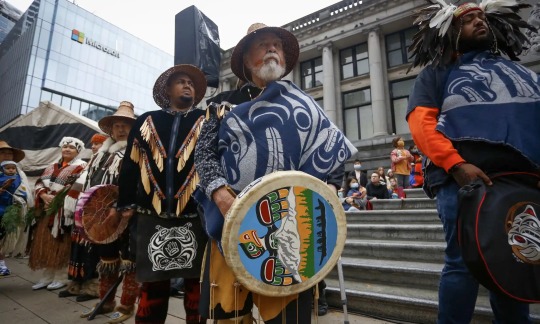
People take part in a first National Day for Truth and Reconciliation event in Vancouver, British Columbia, Canada, on 30 September 2021. Photograph: Xinhua/Rex/Shutterstock
Landmark Deals Give Indigenous Key Role in Canada Resource Projects! YQT Community Signs Unprecedented Agreement with Coal Company Giving Indigenous Leadership ‘Veto’ on Proposed Project
Leyland Cecco in Toronto | Sunday 22 January 2023
Two landmark deals in western Canada could reshape the role of Indigenous nations in resource development projects, placing greater power in the hands of groups that have long been excluded and signalling a possible shift in how industry and governments negotiate with communities on the frontlines of environmental degradation.
In recent years, a string of fierce battles over pipelines have put a spotlight on the fractious nature of resource extraction projects, often pitting First Nations communities against powerful companies.
But this week the Yaq̓it ʔa·knuqⱡi ‘it (YQT), a community in south-eastern British Columbia, signed an unprecedented agreement with the mining company NWP Coal Canada that would give Indigenous leadership a “veto” over the proposed project, dramatically reshaping the power Indigenous nations have over their territory.
Under the deal, the YQT will become the “regulator and reviewer” of the proposed C$400m (US$300m) Crown Mountain project.
“For too long, Indigenous nations have not been brought to the table in decision-making directly affecting our rights and interests,” Chief Heidi Gravelle said in a statement, adding that her community would finally have the change to regulate projects in their own territory.
“We see this as the right thing to do – treating the Indigenous title holders as governments and taking their word seriously,” said Dave Baines, director of project development at NWP, who pointed to dissatisfaction in communities who felt they were inadequately consulted or promises were broken.
“Industry likes to do what has worked in the past rather than try new things. But sometimes you have to not do what’s been done before and make that change.”
With past projects across the country at times facing criticism for a lack of meaningful consultation, Baines said the decision also makes good business sense.
“We’re watching projects get rejected they’re not in alignment with the Indigenous peoples in the area. Is it a bigger risk for us to formally accept them as a regulator and to work with them to get to a yes? Or is it a bigger risk to do the same old thing and possibly face a lawsuit down the road?”
The proposed metallurgical coal mine would open in 2025 if approved by both federal and provincial regulators.
The region is currently the site of coking coalmines with a poor environmental track record: in March, a provincial court fined Teck Resources C$60m after its Fording River and Greenhills operations polluted local waterways with selenium. Other mines have been proposed but faced stiff opposition.
In her statement, Gravelle said the company had committed to a “consent-based environmental assessment”, meaning NWP would require YQT’s permission for the project to move ahead, as well as oversight of the project through the mine’s expected lifespan and remediation efforts.
“Getting a permit for a project is like a marriage: the hard work isn’t standing up in front of the minister, it’s the next 30 years living in each other’s pockets,” said Baines. If we’re going to work with these nations … it’s a journey together. It’s not a single approval.”
In recent years, Indigenous leadership in western Canada have advocated for a greater say in – or even full control over – resource projects that affect their territory.
The deal comes as the Blueberry River First Nations, a community 1,200km away, announced its own historic agreement with the province of British Columbia. In landscape scarred by a relentless push for new industrial development, the deal would see new protections for wildlife, a halt to logging in old-growth forests, new compensation for the community. Any new resource extraction projects will be limited in how much land they can disturb.
“For a long time, First Nations were put aside, not engaged with or listen to,” Chief Judy Desjarlais told reporters as she and the premier announced the deal. “Today marks a new direction. First Nations will be participants in all stages of development. Blueberry now has a say every step of the way.”
The provincial government has also agreed to establish a C$200m restoration fund by to support “healing” of the land from years of industrial disturbance.
In 2021, the British Columbia supreme court sided with Blueberry River, finding the province had violated the nation’s treaty rights by allowing fossil fuel development in the region that had prevented the nation from being able to live off the land.
More deals on revenue sharing and land rehabilitation between the provincial government and First Nations are expected in the coming days.
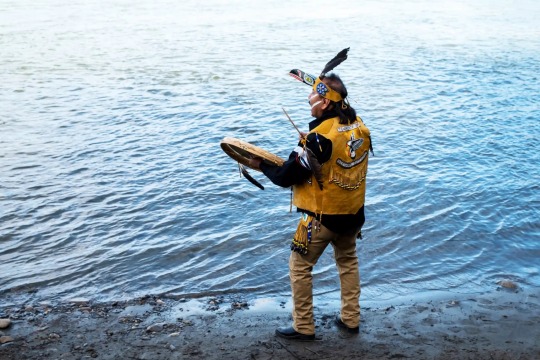
The First Nations Who Live Along the Yukon River are Taking Salmon Conservation into Their Own Hands
Seascape: The State of Our Oceans: ‘A Soul Wound’: A First Nation built its culture around salmon. Now they have to fly it in frozen
As Chinook Numbers Migrating to Canada fall 95% to Record Lows, Communities are Resorting to Importing Fish to Keep Their Traditions Alive
— By Genesee Keevil in Little Salmon Carmacks First Nation. Photographs By Peter Mather
In late summer every year, when buckbrush on the mountains turns yellow and the soapberries grow soft and translucent, families from Little Salmon Carmacks First Nation gather at the mouth of Tatchun creek to fish for their namesake.
The creek itself, in Canada’s far-flung Yukon territory, is named after the fin on a salmon’s back that sticks out of the water as the fish fights its way upstream. Tatchun empties into the Yukon River, home to the world’s longest run of chinook salmon. Elders say the fish used to be so plentiful they could have walked across the water on their backs.
But when Yukon First Nations gathered at Tatchun this summer, it wasn’t to fish. It was, in the words of the Little Salmon Carmacks chief, Nicole Tom, to “call the salmon back”.
A sacred fire burned and there was traditional dancing, drumming, prayers and a feast. “It is very traditional that you make a big pot of fish soup and share the first salmon,” says Tom.
Only now, there is no first salmon. Instead, they had to boil a frozen one, shipped in from Alaska.
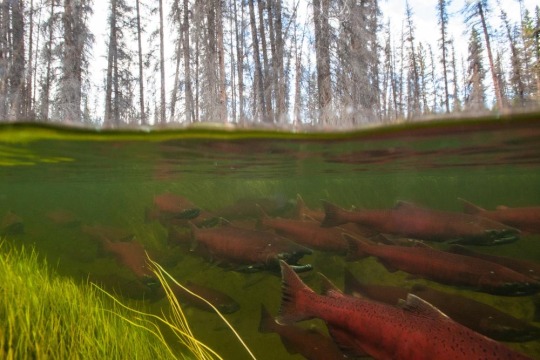
The Yukon River’s salmon runs, once abundant with fish, have declined by a catastrophic 95%
This year marks the lowest run of chinook ever recorded in the Yukon River – down a catastrophic 95% from previous levels, according to experts. Communities throughout the Yukon that have the fish at the heart of their culture are relying on expensive frozen salmon.
Many here fear an integral part of their traditional lifestyle and spiritual identity is about to disappear for ever. “Our name, culture, language, ways of knowing and doing, our intergenerational teaching, storytelling, ceremony – everything surrounds salmon,” says Tom. “Even our vitamins.”
“I Can’t Imagine a World Without Salmon. To Me, That is Unimaginable Poverty, of the Ecosystem, of Culture, of Spirit.” — James MacDonald
As many as 450,000 chinook once entered the mouth of the Yukon River each summer, after spending five years in the Bering Sea, says Teslin Tlingit elder Carl Sidney, who attended the Tatchun salmon ceremony. Once in the river, salmon stop eating and rely on their fat reserves to get them through one of the longest, most formidable freshwater migrations on the planet. The Yukon River stretches 3,200km (2,000 miles) across Alaska, into the Yukon territory and south to its headwaters. About 200,000 chinook would push upriver to Canada each year, darting past predators and fishing nets to spawn in the streams where they once hatched.
Then, after dwindling for decades, salmon stocks suddenly plummeted. Last year, little more than 32,000 chinook made it upriver to Canada. This year, it was fewer than 12,000. No one knows precisely what caused the crash, though a number of factors are likely at play, from problems in the ocean, including commercial overfishing and bycatch, to climate breakdown, disease and competition from hatchery fish.
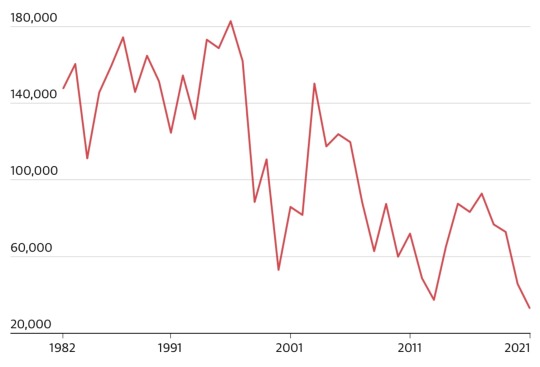
The Estimated Number of Canadian Chinook Salmon in the Yukon River fell to 32,970 in 2021. Guardian Graphic. Source: Alaska Department of Fish and Game
The impact of growing up without salmon is affecting a whole generation, says Sidney. As a boy, his family caught 100lb (45kg) chinook that weighed twice as much as he did. In a week, they’d harvest enough fish to feed five families for a year. “I was pretty much raised on the land, by the land, and salmon were one of the staple diets of our people.”

Carl Sidney (facing camera, check shirt) at the ceremony ‘To Call The Salmon Back’
Sidney’s people still rely on salmon, even though it’s flown in. His First Nation has set up workshops to teach young people traditional ways of cutting and drying salmon. Other Yukon First Nations are even trying to keep fish camps alive using frozen salmon, but it’s not the same, he says.
As chinook numbers have declined, many local families have turned to plentiful chum salmon for sustenance – a fish that was historically used to feed dog teams. “We’ve been working to change the perception of chum,” says David Curtis, a fisher based in Dawson City.
Now, chum numbers are also plummeting. This year’s run is the second lowest on record, surpassed only in 2021. “This is red-alert time,” says Curtis. “This is not just about human needs; it’s about the whole ecosystem and the nutrients from the salmon that go to the bears, wolves, trees, berry plants – the whole riparian zone.”

Annual fish camps were part of the Teslin Tlingit culture, where enough salmon would be caught, filleted and hung from poles ‘Like Drying Laundry’
“I am living through the extirpation of these species,” says the Yukon Salmon Subcommittee chair, James MacDonald. “In my lifetime, I can see that happening.” MacDonald has photos of himself as a little boy holding 42lb salmon at his family’s fish camp. He can’t recall the last time he fished.
“We’ve got all these resources for salmon,” says MacDonald, who sits on the Yukon River Panel, established to co-manage salmon under the Pacific salmon treaty’s Yukon River salmon agreement. “We’ve got a treaty to prescribe how we are going to manage salmon, and what we can expect for salmon returns – we just don’t have any salmon.”
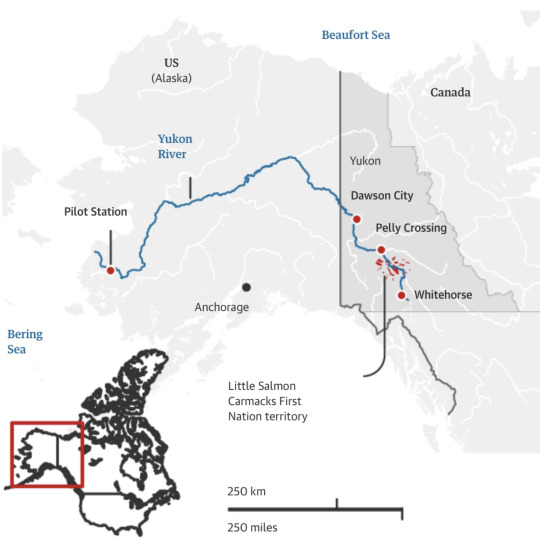
Guardian Graphic! Chinook Salmon Migrate 3,200km up the Yukon River from Alaska to Canada
Until recently, Alaska’s commercial fisheries, as well as subsistence fishers along the Yukon River, harvested unlimited numbers of chinook destined for Yukon spawning grounds. “They were so bountiful we never considered net-size restrictions, or windows of when to fish or not fish, or how many fish you could take,” says MacDonald.
A moratorium on Yukon River chinook fishing was finally put in place in 2021. Many believe it is too little, too late. “We could have pumped the brakes a lot sooner,” says MacDonald. “It’s no longer about conservation. We are fighting for survival of these species.”
Still, he isn’t giving up hope. Some Yukon First Nations have started in-stream incubation programmes and are considering fully fledged egg-rearing facilities, as well as hatcheries. Hatchery salmon are not the same as wild stocks, but it it better than nothing, he says. “I just can’t imagine a world without salmon. To me, that is unimaginable poverty. It’s a poverty of the ecosystem; it’s a poverty of culture; it’s a poverty of spirit.”
Despite the moratorium, chinook destined for the Yukon are still being caught as bycatch. In 2021, pollack fisheries in the Bering Sea and Aleutian Islands caught more than half a million chum and chinook. Bycatch has always occurred, but with runs so critically low it could now have a biological effect, says Holly Carroll, an Alaska biologist and manager of the Yukon River federal subsistence fisheries.
She doesn’t blame bycatch alone. Overfishing, as well as commercial fisheries’ practice of catching the largest and most fertile females, has resulted in smaller chinook that lay fewer eggs and have lower reproductive success.
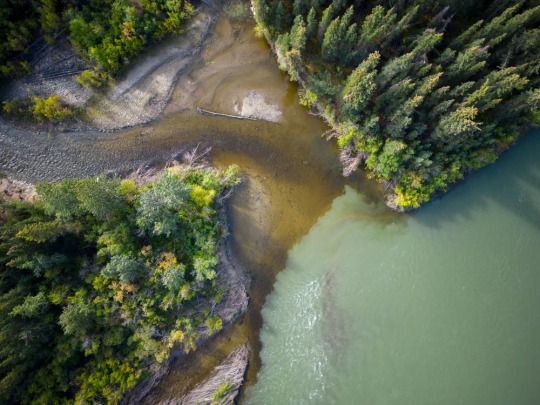
The Yukon River stretches 2,000 miles across Alaska, into the Yukon Territory
Climate breakdown, too, is causing marine heatwaves and algae blooms in the Bering Sea, affecting salmon and their marine food web. The Yukon River’s average temperature is increasing and salmon do not do well in warm water, says Carroll. Fluctuating river levels and turbidity from higher than normal snowpack, melting glaciers and permafrost are messing with salmon migration. There has been a resurgence of a parasite called ichthyophonus, which is fatal for fish, while pollutants and invasive species are all playing a role.
Across the Pacific as a whole, commercial fisheries harvest close to 2m tonnes of salmon and steelhead annually – the equivalent weight of six Empire State Buildings – while in Alaska’s Bristol Bay, fishers broke records this summer, harvesting 46.6 million sockeye salmon.
“We have original agreements with the salmon,” Tom says. “Before land-claim agreements, our first agreements were with the animals, the land, the plants, the trees, the air and the water. If we look after and respect them, they will look after and respect us.”
Indeed, First Nations along the river used to spend late summer and early fall at fish camps, where families, including aunts and uncles, elders and children, would gather to catch a year’s worth of food. Crimson fillets of salmon were cut and hung like drying laundry over rows of poles to preserve the fish for the cold months ahead.
Fish camp was hard work, says Tom, but also a time for stories, laughter, celebration and learning traditional ways of respecting the fish and one another. Whenever Tom passes the Yukon River, she gives thanks. So do her children.

Yukon First Nations at a salmon gathering this year
Now her seven-year-old daughter, who went to fish camp as a little girl, keeps asking when they can go again: she wants to learn how to cut fish. “That’s heartbreaking,” says Tom. “It’s a soul wound, not to be able to practise your culture.”
Canada’s attempt to phase out open-pen salmon farms faces setback
This year, Tom decided not to buy frozen salmon to help feed her First Nation. “We brought in a bunch of frozen salmon last year, but are unsure of how to deal with that piece because you are buying it from the fisheries who are part of the problem in the ocean,” she says. “It’s contributing to the problem without actually figuring out what the issue is and how we solve it.
Yukon First Nations are grieving, she says. “We have traditional teachings about not dragging nets, or messing with salmon, or having fish farms, and that speaks to what is happening in the ocean. It’s against traditional law.” But they don’t need that traditional knowledge preserved for posterity, says Tom: “We need it instilled in power-making decisions.”
Sidney says: “It’s almost the end of the salmon.”
0 notes
Photo
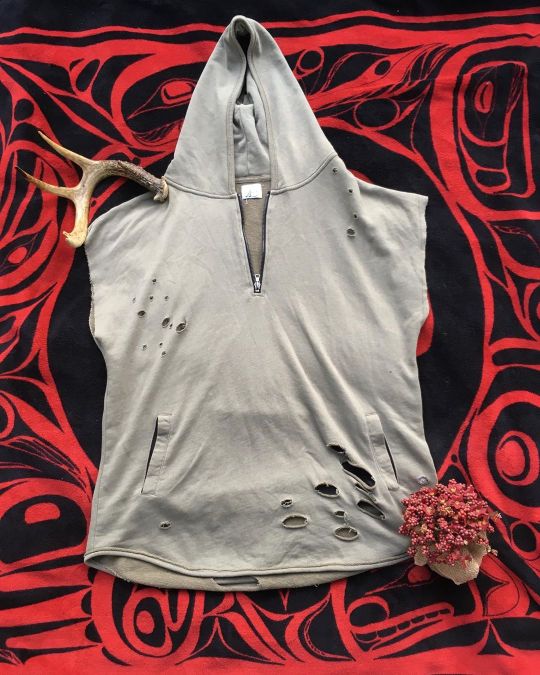
Moss Green Sleeveless Hoodie * $20.00 * Ladies large but fits like a loose XXL * lined pocket * EUC * ^ ^ ^ Comment “mine” to claim it🍾 ^ ^ #thunderbay #thunderbayontario #tbay #vintagetbay #thriftyfinds #wildcatvintagetbay #yqt #secondhand #preloved #shoptbay (at Thunder Bay, Ontario) https://www.instagram.com/p/CFNuidWBiNp/?igshid=ic3xkpzm872o
#thunderbay#thunderbayontario#tbay#vintagetbay#thriftyfinds#wildcatvintagetbay#yqt#secondhand#preloved#shoptbay
1 note
·
View note
Text
Fall is here
Now that the leaves are all off the trees and the weather is cooling off you are wondering what there is to do?
Thunder Bay is full of some great indoor adventures just waiting to be explored. Here are a few fun and family fun activities to do
Thunder Bay Historical Museum
The Thunder Bay Historical Museum is filled with 3 floors of Thunder Bay history. On the first floor, you will find Thunder Bay throughout the eras, including the silver mines at Silver Islet, and fur trading. On the second floor is a rotating display which changes up every season, The third floor is home to the military and musical history in Thunder Bay.


Thunder Bay Art Gallery
The Thunder Bay Art Gallery is home to largest Indigenous art collection. The gallery is home to 3 separate galleries that rotate throughout the year. They home over 1600 works of arts in their permanent collection.
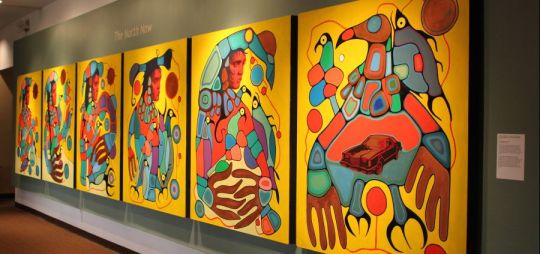

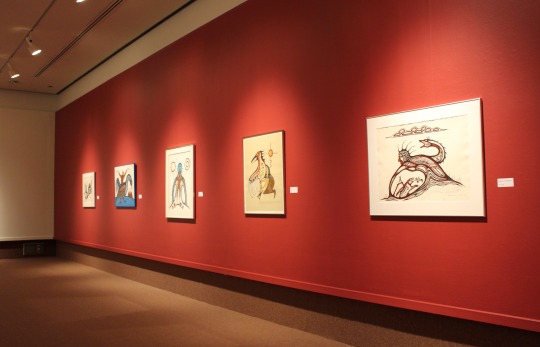
Thunder Bay is also home to a number of other art galleries, and museums throughout the city. For more information you can visit the city of Thunder Bay’s website at http://www.visitthunderbay.com.
0 notes
Text
d!d ! l!> yz nt p(tm)tch!qyr!(tm)y? t>(tm), t>(tm) ! d!d
#! jv(tm)y cqmt br!mg nt(tm)>lf yz yrv(tm)y h>r zr qmt qdvly w!yh nt przbl>n(tm) (tm)z ! jv(tm)y (tm)yqt qv!>y#!y(tm) mzy l!k> !y wzvld nqyy>r#yh>t dzmy qcyvqllt cqr>#theos coded rambles
2 notes
·
View notes
Text
It really isn’t fair for them to bring someone as wonderful as Ye Qingti into this because how can you NOT ship him and Fengjiu?????
At least in the book, they were actually married??
#besanii watches pillow book#okay so i'm like 10000% on YQT's team#i KNOW it's meant to be dongfeng#BUT STILL#also no spoilers but if we're going by the novel this won't be the last we see of him :) :) :)
4 notes
·
View notes
Photo

[IG][171116] HIMCHAN POSTED A PIC OF JONGUP
Caption: A! Today of all days, I just want to scold Moon Jongup. I want to scold him in advance. That’s right. So far, I’ve never once scolded him properly. For this, I want to scold him more. Today of all days, I want to scold Moon Jongup.
Jongup commented:
Please scold me!! Please scold me!!! 😉
Translated by him-up | PLEASE TAKE OUT WITH CREDITS
#himup#himchan#jongup#himchan's instagram update#171116#why does this sound like a song lyrics?#and wth?#ahrlqyt;yqt
352 notes
·
View notes